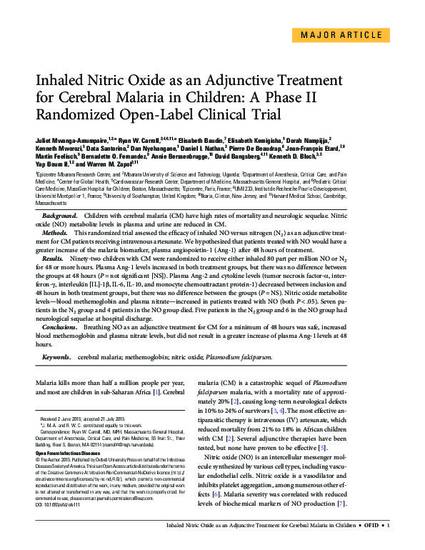
- Nervous system -- Diseases,
- Neurology -- Sub-Saharan Africa,
- Malaria -- Children -- Treatment,
- Nitrous oxide -- Therapeutic use -- Clinical trials,
- Plasmodium falciparum
Background. Children with cerebral malaria (CM) have high rates of mortality and neurologic sequelae. Nitric oxide (NO) metabolite levels in plasma and urine are reduced in CM.
Methods. This randomized trial assessed the efficacy of inhaled NO versus nitrogen (N2) as an adjunctive treatment for CM patients receiving intravenous artesunate.We hypothesized that patients treated with NO would have a greater increase of the malaria biomarker, plasma angiopoietin-1 (Ang-1) after 48 hours of treatment.
Results. Ninety-two children with CM were randomized to receive either inhaled 80 part per million NO or N2 for 48 or more hours. Plasma Ang-1 levels increased in both treatment groups, but there was no difference between the groups at 48 hours (P = not significant [NS]). Plasma Ang-2 and cytokine levels (tumor necrosis factor-α, interferon- γ, interleukin [IL]-1β, IL-6, IL-10, and monocyte chemoattractant protein-1) decreased between inclusion and 48 hours in both treatment groups, but there was no difference between the groups (P = NS). Nitric oxide metabolite levels—blood methemoglobin and plasma nitrate—increased in patients treated with NO (both P < .05). Seven patients in the N2 group and 4 patients in the NO group died. Five patients in the N2 group and 6 in the NO group had neurological sequelae at hospital discharge.
Conclusions. Breathing NO as an adjunctive treatment for CM for a minimum of 48 hours was safe, increased blood methemoglobin and plasma nitrate levels, but did not result in a greater increase of plasma Ang-1 levels at 48 hours.

Originally appeared in Open Forum Infectious Diseases, volume 2, number 3; published by Oxford University Press.
At the time of writing, David Bangsberg was affiliated with the Center for Global Health and Harvard Medical School.